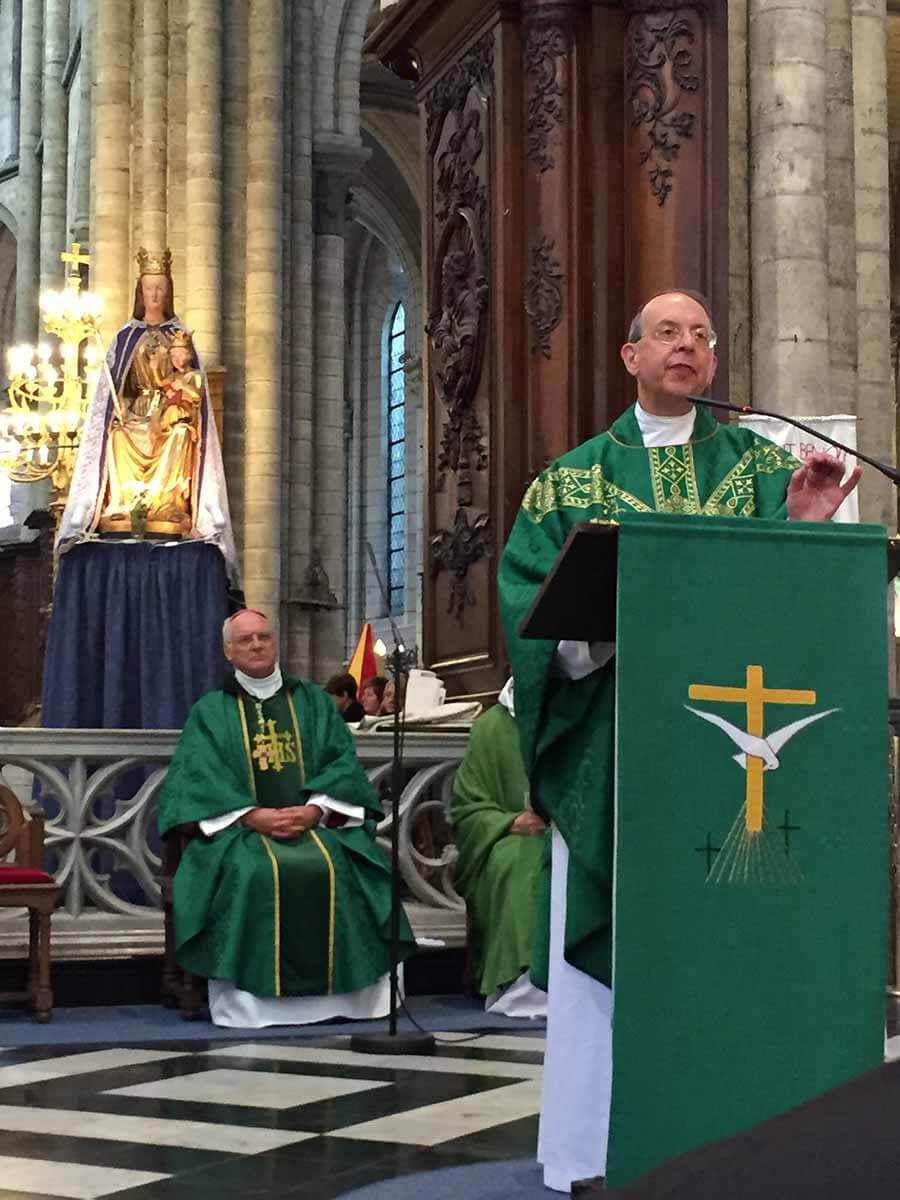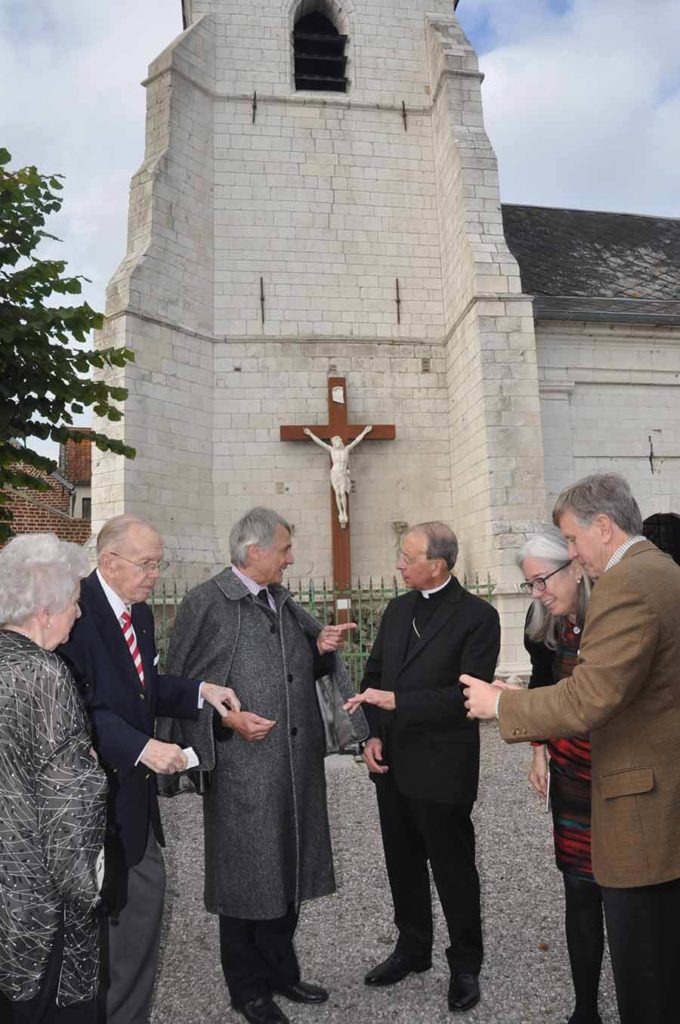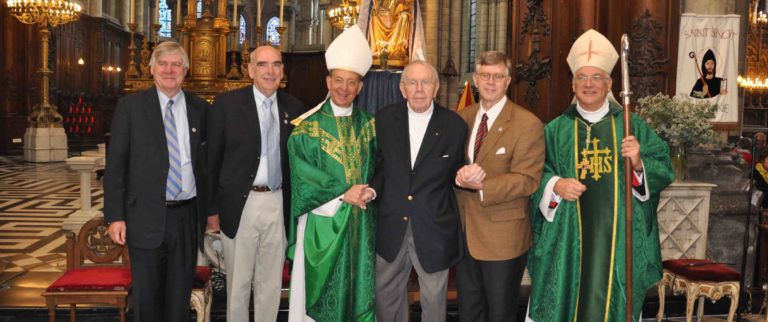SAINT-OMER, France – As Archbishop William E. Lori and a small delegation visited this small northern French town in mid-October for a weekend of festivities, daily Masses highlighted the differences and the connections between France and the United States.
The Masses were all celebrated in churches built centuries ago.
The archbishop celebrated a Mass Oct. 13 for his delegation and a few people from Salperwick, a small town two miles from Saint-Omer, at Mother Teresa in Morinie Parish, named for St. Teresa of Kolkata and the region in France where the church is located. He began “this small pilgrimage” by praying the votive Mass of the Sacred Heart in honor of St. Mary Alocoque, who received the vision of Jesus as the Sacred Heart nearby.
Archbishop Lori noted that in this same church nearly 100 years ago, American soldiers gathered during World War I to pray. “Let us remember those who gathered here a century ago as we pray for peace.”

He noted that he and other pilgrims had gathered at Saint-Omer “to begin honoring the designs of God’s heart as they relate to Daniel Carroll, Charles Carroll and John Carroll,” who attended the College of the English Jesuits there in the 1740s. It was here that they “formed their dedication to a new nation, conceived in liberty.”
The archbishop added that the Mass provided a chance to pray for France and the United States and for the difficult times in the world in which we find ourselves.
The Maryland delegation included Archbishop Lori and his secretary, Father Lou Bianco; Father Charles Connor, assistant professor of church history at Mount St. Mary’s Seminary in Emmitsburg; Sulpician Father Daniel Moore, director of discernment for the Sulpicians’ U.S. Province; and descendants of the Carroll families.
Charles Carroll Carter Sr., his wife, Rosemary, and their son Charles Carroll Carter Jr., about eight generations descended from Daniel Carroll of Rock Creek, came from Maryland. Harper Wright, originally from Maryland and a descendant of Charles Carroll of Carrolton, accompanied by his wife, Janet, came from their residence in England for the events.
Archbishop Lori, the 15th successor of Archbishop John Carroll, represented the spiritual descendants of John Carroll.
First Mass in two centuries
The Chapel of the Jesuits in Saint-Omer was probably last used as a church during the French revolution in the early 1790s, when the Catholic church was suppressed, religious symbols were taken down and churches were closed. In succeeding decades, the space at various times served as a horse stable, a wartime warehouse for aircraft parts and a parking garage.
The chapel has been converted to a new arts and performance space for the town of Saint-Omer. As workers put finishing touches on the building Oct. 14 to prepare prior to official opening festivities for the renovated chapel later in the day, Archbishop Lori celebrated Mass – probably for the first time since the French revolution – in a small chapel behind what would have been the main altar. The local bishop of Arras, Boulogne and Saint-Omer, Bishop Jean-Paul Jaeger, concelebrated. Priests from Maryland also concelebrated, and the Carroll descendants – the Carters and the Wrights – attended.
Celebrating the traditional Saturday Mass in honor of the Blessed Virgin Mary, the archbishop called her “the pre-eminent woman of faith, the simplest disciple of the Lord.”
He recalled a quote from Archbishop Carroll shortly before his death, that of all the things that gave him the most comfort at that moment were his connection to Mary and that he had entrusted the people in his care to her.
Friendship Mass
At the Cathedral of Notre Dame in Saint-Omer Oct. 15, Bishop Jaeger celebrated a Franco-American friendship Mass to reflect on the connections between the countries.
Preaching the homily in English, with his text provided in French to all the Massgoers, Archbishop Lori said, “One cannot study the founding of the United States without acknowledging the critical role played by France. During the American Revolutionary War, in 1778, France recognized and allied itself with the United States and sent its army and navy to fight on the side of this fledgling nation.”
But the influence of France on the United States was not limited to political ties. “I think of the influence of the Enlightenment in helping to shape the American experiment in limited government and ordered liberty,” the archbishop said.
“Throughout this weekend, we have been celebrating, if you will, a subset of that larger picture of French-American friendship by focusing on what drew another leading American colonial family to send their sons across the Atlantic Ocean to be educated.” In some respects, he said, the Carroll family was handicapped by their Catholic faith.
“It was out of the question that Daniel, John and Charles Carroll would matriculate at Harvard College or the College of William and Mary, as did their social peers. Nor was it possible for them to obtain a Catholic education in England owing to the continuance of the Penal Laws. And thus it was that the decision was made to send their children to Saint-Omer and to entrust their education, indeed, their formation, to the Society of Jesus. …”
“It was here at St. Omer,” Archbishop Lori continued, “that these young men who would go on to play such important roles in early days of my country, received a splendid education, rooted in an authentic Christian humanism, capturing the wisdom of ancient Greece and Rome while transforming it through the reasoned faith of the medieval masters.”
The archbishop acknowledged a debt of friendship: “Here at Saint-Omer, John Carroll received his calling to enter the Society of Jesus. … As the first Bishop of Baltimore, it would be John Carroll’s mission to find the path for the Catholic faith to take root and grow in the new republic, a wholly new environment for the faith, an environment of religious freedom laced with deep anti-Catholic sentiments.

“His formation at Saint-Omer helped make him a wise and astute leader and to this day we are building on the foundations John Carroll so carefully laid. As a successor to John Carroll, I came here to St. Omer to express my deepest thanks,” the archbishop said.
Closing the homily, he said, “May we unite – France and America, in these days when secularism reigns – in strengthening not only the bonds of friendship but also the bonds of faith that enable us to serve the Church and the common good of our global culture.”
After the Mass, a reception was held in a side chapel of the cathedral, built in the 11th and 12th centuries on the site of a seventh-century church and rebuilt and expanded over succeeding centuries.
The belfry, built in 1492, was recently renovated, and along with it the six bells in the tower were replaced and brought back to life. The Archdiocese of Baltimore contributed one of the bells, a smaller one named “Domatille.”
Anne Pierard, a member of the Friends of the Cathedral, noted that at one point, the bell tower was so structurally deficient it could no longer support the weight of the bells. She said each of the new bells has a name, because each has its own “personality.”
With the renovation, the six bells, including the largest, which weighs five tons, can ring.
Noting that church bells peal to call people to prayer, to warn townspeople, to mourn for the dead or to celebrate joyous occasions, Pierard said, “Bells have a special way to win our hearts. Today they ring just for joy.”
Archbishop Lori noted that the cathedral, also a basilica, is a beautiful and warm place. “God has been worshipped here for more than 900 years.” He said he and the Archdiocese of Baltimore were happy to play a small part in the bell tower’s renovation.
From France to Maryland
Before departing France, the archbishop and the group from Maryland made one last stop in Aire-sur-la-Lys, a slightly smaller town about a half hour from Saint-Omer.
There, they stopped by the birthplace of Father Narcisse Martin, a French priest who served in Maryland.
Father Martin (1845-1923) was a philosophy professor in Rodez, France; Montreal, Canada; and at St. Mary’s Seminary in Baltimore. He was a noted expert on the Eucharist, and wrote a treatise in Latin on the sections about the Eucharist in St. Thomas Aquinas’ “Summa Theologica.”
He also served as a chaplain at St. Agnes Hospital before requesting to be assigned to a parish. He served as pastor of St. Peter Church, Waldorf, with a special focus on serving the poor, from 1894 until his death.
The archbishop celebrated a Mass for about 50 people at the nearby Jesuit Chapel of St. Jacques, built between 1682 and 1688, where Mass is celebrated about once a year.
Archbishop Lori noted the deep link between “this beautiful city and Maryland especially through Father Narcisse Martin,” adding that the pilgrimage to the Pas de Calais region would not have been complete without the visit.
He thanked the people of Aire-sur-la-Lys for preparing Father Martin for service. “You have given us a great gift – a holy priest, a seminary professor, a hospital chaplain and a pastor. For that reason, we come together in friendship.”
Also see:


